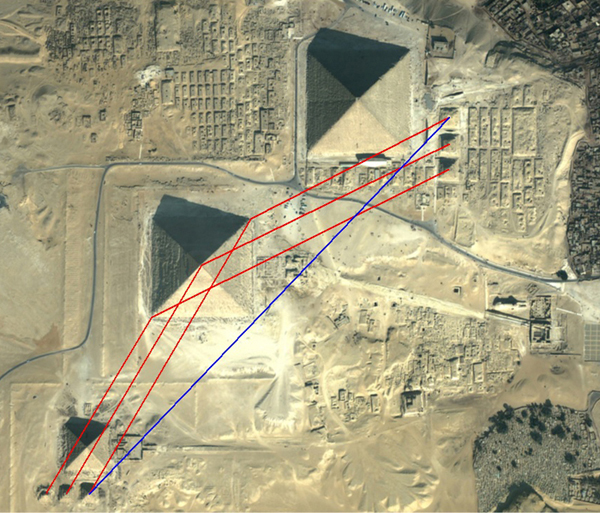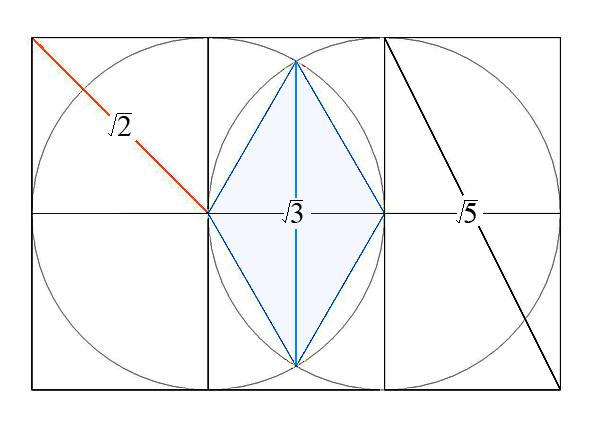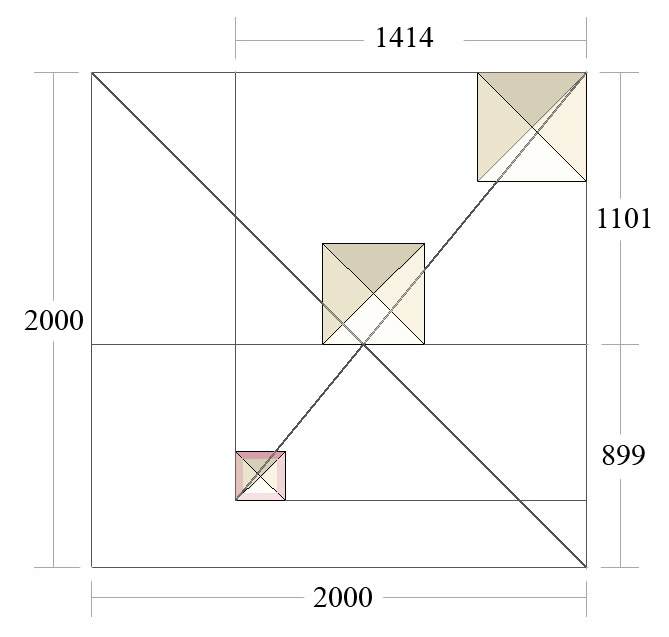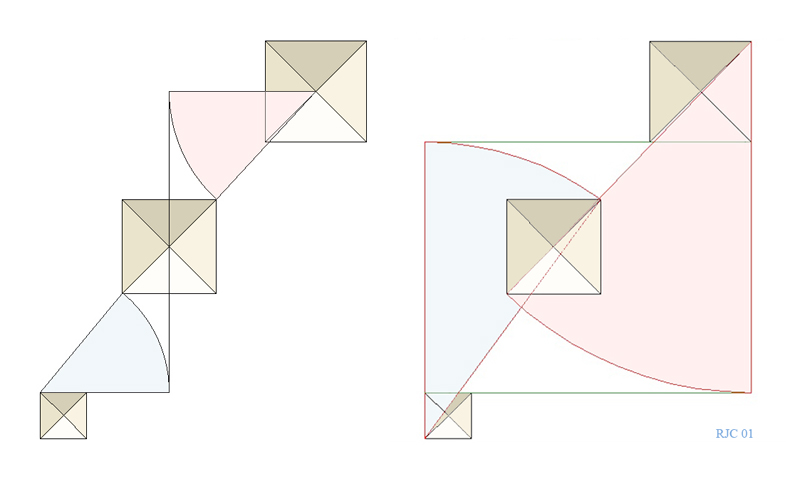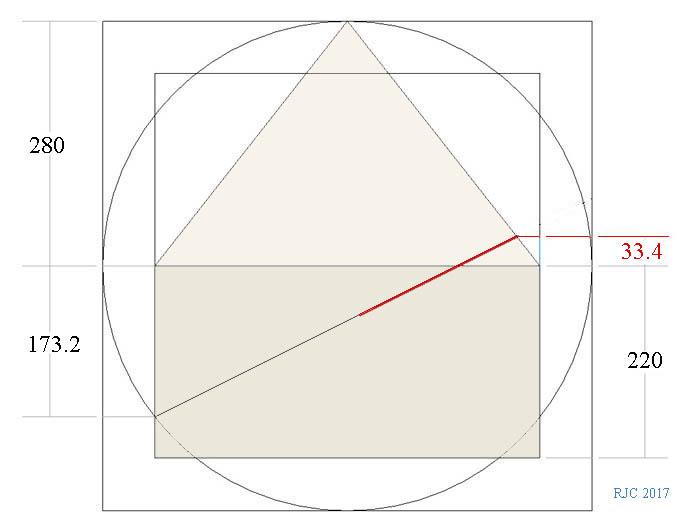

robincook
Members-
Posts
9 -
Joined
-
Last visited
Content Type
Profiles
Forums
Events
Everything posted by robincook
-

The geometric design of the Giza pyramids
robincook replied to robincook's topic in General Philosophy
Ok, I'll try to summarize. I must confess that in my youth I was prey to many outlandish ideas which I have now rejected. I accept the conventional Egyptological account and dating. But in one regard I do not - Egyptologists write as if each king built (designed?) his own pyramid. After first visiting Giza in 1979 I noticed something that set me thinking. Looking at plans of Giza I noticed a pattern related to the central pyramid – the prominent satellite pyramids of Khufu and Menkaure being so placed that they appeared to form parallel alignments to the centre and corners of Khafre – as shown in the first attachment. These alignments are by no means perfect but appear to form a pattern of roots (second attachment). Red 26.5 (diagonal of double square) and 30, blue 45 degrees. The definitive Giza survey was made by Petrie (Petrie, W. M. F. [1883] 2002. The Pyramids and Temples of Gizeh. London: Kegan Paul. https://www.ronaldbirdsall.com/gizeh/petrie/index.htm). Legon (http://www.legon.uk) converted Petrie's measurements into native units of measure and discovered a plan based on the very same three roots (third attachment). Unfortunately his findings have largely been ignored by Egyptologists. Nevertheless I remained convinced that the central and most dominating pyramid at Giza sitting on prime real estate, Khafre, appeared to act as a reference, or 'mediator', between the other two pyramids, Khufu and Menkaure, which share certain design similarities to each other. (Perhaps evoking the theme of duality said to pervade Egyptian thinking. ) Other geometric elements appear non-coincidentally, like Phi and the Fibonacci series. As with the ability of the Egyptians to assimilate seemingly contradictory mythologies, the Giza architects appear to have assembled a collection of geometrical and numerical ideas and given them a kind of metaphorical meaning. (Perhaps the mystery so commonly associated with the pyramids is but a distant echo of a hidden tradition.) But did the builders really believe that this edifice of geometry and cut stone would launch the king to a stellar afterlife? Or is it possible that shrewder minds existed within the priesthood that we might perhaps identify as philosophers or scientists? A picture is worth a thousand words. My work is visual, containing over a hundred illustrations, and it would be a pointless chore to try to describe them in words. But here is a final diagram showing arcs which can be drawn to the corners of Khafre (fourth attachment). Serendipity? I hope this brief summary will help to answer your question. In the fullness of time my site may become more accessible and only then will a real discussion become possible. Robin -

The geometric design of the Giza pyramids
robincook replied to robincook's topic in General Philosophy
That seems a bit harsh. I am extremely interested in 'an objective discussion of known facts to sort the supposition from the supportable' (aye, back in the ghetto we used to talk of little else). But first the 'known facts' must be presented - which I have tried to do on my website. But since forum rules ban presentation of websites what am I expected to do? Answer piecemeal questions like on a game show? The moderators here will have access to my site and therefore in a position to assimilate the data and be able to answer their own questions if they want to. Anyone else must guess what I'm talking about, even though I have tried to answer queries as best I can. Your comment comes across as a getout dressed up in fancy language. If you are not interested in pyramids, just say so. What contradictory claims? could you be more explicit in your responses?- 37 replies
-
-1
-

The geometric design of the Giza pyramids
robincook replied to robincook's topic in General Philosophy
Yes Studiot there have been many investigations of Egyptian pyramids. Have you read them? What have you learned from these investigations? I have read as much as I have been able to find and am not impressed. You also ask - "So I ask you again which egyptologists ?". Having been warned that this thread will be closed down if I provide any outside links I am prevented from answering your question. Sorry Swansont, what point are you trying to make?- 37 replies
-
-2
-

The geometric design of the Giza pyramids
robincook replied to robincook's topic in General Philosophy
hi exchemist, You seem to be making a mountain out of a molehill - the Giza pyramids were designed and built by native Egyptians over a span of years from about 2580 BC to 2500 BC. Of course the height of Khufu was made 280 cubits by design. The fact that the builders saved a great deal of work and stone by terracing the rocky knoll over which Khufu was built is irrelevant. I wonder why you think that cutting steps precludes the builders from designing whatever they wanted? What have I written that gives you this idea? Egyptologists maintain that the pyramid architects did not know Pi. The value of Pi 22/7 found in Khufu is thought to be coincidental. However I found that the descending passage of Khufu (probably the first element to be created at Giza) appears to have been laid out according to the circle squared scheme. (But if you can find a better explanation for the passage layout I'd love to hear it.) This suggests that the architects did 'know Pi' but had little interest in calculating more precise values, as Mesopotamians did. Lightbody has proposed that the circle was viewed as a symbol of 'protection' . Actually that is the reason for posting in this philosophy forum - now that Khufu has been analyzed what did this geometry mean to the architects? Why design a pyramid on the basis of Pi and Phi? The vast majority of Egyptians could neither read or write and were highly superstitious. Of course they were aware of the tomb narrative, could witness for themselves the rising, culmination, and setting of their star gods in the sky; the intervisibility of pyramid sites across the Nile and the positioning of pyramid sites to correspond to the setting of prominent Decanal stars. But when they were drafted to build pyramids they had no way of appreciating the sophisticated design upon which they were working. So yes, the design of Khufu must be attributed to a priestly caste. (Unless you believe kings were capable of designing pyramids 😉 -

The geometric design of the Giza pyramids
robincook replied to robincook's topic in General Philosophy
sorry swansont, what previous sentence is that? -

The geometric design of the Giza pyramids
robincook replied to robincook's topic in General Philosophy
Hello Studiot, Supporting evidence and references are listed on my website. The essential survey data to back up the claim for Pi and Phi in Khufu is that provided by Petrie, available on the net here - http://www.ronaldbirdsall.com/gizeh/petrie/index.htm As to my point - many see pyramids as useless piles of stone constructed to massage the egos of vainglorious kings. Others imbue the pyramids with all kinds of mysticism. However, by looking at the survey data for the Giza group, interesting positional relations appear and these need to be explained, whatever one's point of view. So my first step is to present the data, such as it is. Once this data has been assimilated one must ask what does it all mean? My tentative conclusion is that at the height of Egypt's prosperity (that is during the reigns of Sneferu and Khufu) a mathematically inclined priesthood had for a moment gained power - although it was not to last because of climate change towards the end of the IVth dynasty; the state became poorer and subsequent pyramids were smaller, more shoddily built, and lacking the kind of geometry we see at Giza. Perhaps this is the wrong section to have put my post but at Giza we seem to be dealing with a mathematical philosophy. It had been my hope that, after assimilating the data, there would be something to discuss. robin This idea was promoted by Mendelssohn about 40 years ago, but pyramids have cores cut into steps so no go. Besides only three pyramids have the 'Pi slope'. No. The designers were Egyptian. The question is what metaphysical significance they attributed to their geometric conceits. -

The geometric design of the Giza pyramids
robincook replied to robincook's topic in General Philosophy
I think I should mention that many scholars have addressed the question and overwhelmingly Egyptologists believe that the Egyptians did not know Pi. They concede that the Egyptians used a rough approximation for what we call Pi, calculated by squaring 8/9 of a circle, giving a value of 3.16 - sufficient for estimating the volume of containers - in other words squaring by area. Squaring by circumference is what is usually meant by 'squaring the circle'. The meridian section of Khufu is governed by SEKED 5 cubits 2 palms (in other words height 14 base 11). The fact that these figures produce a value for Pi of 22/7 is considered a coincidence. The whole point of my paper is to demonstrate that, by laying out the descending passage according to the 'circle squared diagram', the pyramid builders were well aware of the concept. It should be noted that Khufu was also designed using Phi - in the overall design of the pyramid as 356/220 (reducing to the Fibonacci terms 89/55), and to determine passage junctions within the pyramid. There is also evidence that the same Fibonacci terms were used in pyramid layout. -

The geometric design of the Giza pyramids
robincook replied to robincook's topic in General Philosophy
Dear Swansont, Ok I'll try to summarize (assuming readers have at least a passing acquaintance with the Giza complex - if not refer to Wikipedia to get up to speed). Most people today see pyramids as the useless products of a vainglorious elite (albeit at the same time being the focus of popular mysticism). However, if we concentrate on the architectural design of pyramids some surprising relations emerge which are yet to be explained. Egypt is viewed as a 'craft culture' - assiduously building giant structures in cut stone using the simplest of tools and methods. The Egyptians pushed the limits of what man can achieve using such means. But they were also very meticulous in realizing their designs, and in pyramid complexes we are presented with a large amount of architectural data. Unfortunately it cannot be said that pyramids have been exhaustively surveyed (we still do not know with certainty the upper slope angles at Dashur). Only at Giza do we have Petrie's precise survey. Converting Petrie's measurements into native units of measure produces a rational plan for the arrangement of Khufu's inner passages and chambers. In addition a definite positional relationship exists between the three large pyramids. My site is a collection of analyses (citing a number of authors) which have led me to this conclusion. For the most part they should be easily comprehensible (involving the roots of 2, 3, and 5, Pi and Phi) but there are other relations which lack explanation. So I'm hoping to get some feedback from scientists looking at the purely mathematical aspects of these curious structures. When they get to see them that is. robin ps. in the attached image a solution to the layout of the descending passage in Khufu is presented. It derives from the notorious 'circle squared diagram. (All agree that the passage is laid out on the diagonal of the double square. However, beginning with the intersection of the circle and the square 173.2 cubits below base, the axis should emerge 33.6 cubits above pyramid base but the angle of the masonry built section is very slightly less than the rock cut part.) I wrote a short paper on this but I don't know if I am allowed to show it on this website. Please delete if so - -
I have published a website - url deleted This site examines the geometrical design of the Giza pyramids, summarizing the findings of a number of authors, as well as describing the latest astronomical findings. I have approached egyptologists but with little response so far - perhaps they write me off as a fringe author. However I continue to plough ahead hoping to receive feedback on what I have written. It occurred to me that if I were to post on a scientific forum I might get a more impartial response. I hope it's ok to post in the general philosophy section - I don't know which would be a better section to post in. robin

